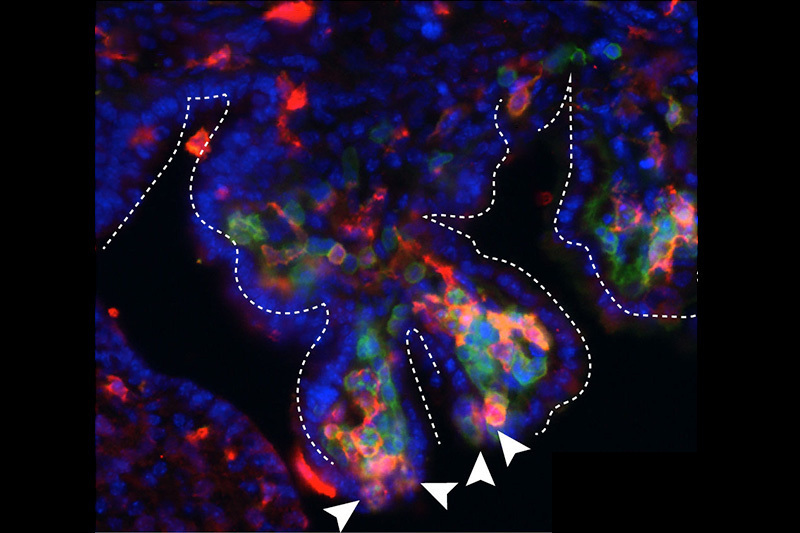The tiny choroid plexus protects the prenatal brain — but may also pass on inflammation from the mother

Floating in fluid deep in the brain are small, little-understood fronds of tissue. Two new studies reveal that these miniature organs are a hotbed of immune system activity. This activity may protect the developing brain from infections and other insults — but may also contribute to neurodevelopmental disorders like autism.
Key takeaway
This pioneering work offers an unprecedented, real-time view of the brain’s choroid plexus. It suggests how disturbances of the mother’s immune system during pregnancy may disrupt early brain development.
“There is a correlation between maternal illness during pregnancy and autism, and we wanted to investigate how this is happening,” says Maria Lehtinen, PhD, a neurobiologist at Boston Children’s Hospital who led both studies. “It’s a very challenging process to study in the lab.”
The Lehtinen laboratory, part of Boston Children’s Department of Pathology, is one of the few in the world to study the choroid plexus. Anchored in each of four channels in the brain called ventricles, the choroid plexus produces the cerebrospinal fluid (CSF) that bathes the brain and spinal cord. Lehtinen has shown that the choroid plexus regulates brain development by secreting instructive cues into the CSF. It provides a protective brain barrier in early life, preventing unwanted cells or molecules in the blood circulation from freely entering the brain.
But what happens when that barrier is challenged? The lab’s new work offers an unprecedented real-time view of the choroid plexus in a mouse model, providing a glimpse of how disturbances of the mother’s immune system during pregnancy disrupt the developing brain. It shows that the choroid plexus can act as a conduit for inflammation caused by maternal infection, stress from the environment, or other factors.
A window on the choroid plexus
Because it’s so deep in the brain, the choroid plexus is very difficult to view. So the first study, published in Neuron, built special imaging tools to capture the action of cells in and around the choroid plexus in adult mice. It was led by Frederick Shipley, PhD, Neil Dani, PhD, and Lehtinen at Boston Children’s and Mark Andermann, PhD, at Beth Israel Deaconess Medical Center.
The researchers carefully removed part of the skull bone and inserted a piece of clear plexiglass, creating a “skylight” into the brain. Using live two-photon imaging, which provides three-dimensional views of deep tissues, they were able to observe the choroid plexus in real time. They monitored changes in calcium (a proxy for cellular activity), tracked the movements of immune cells (as shown below), and measured the secretions of cells in the choroid plexus.
The choroid plexus, inflammation, and the developing brain
Jin Cui, PhD, led the second study, in today’s Developmental Cell. Her team applied similar techniques to observe how maternal inflammation affects the brains of embryonic mice. To mimic maternal inflammation, they introduced a molecular messenger known as a cytokine into the embryos’ brains. This artificially triggered an inflammatory immune response. Then, researchers carefully placed the embryos in an imaging chamber and conducted two-photon imaging of their brains through a tiny “skylight.”
“We wanted to see how the maternal immune response propagates into the brain, and how the choroid plexus responds to external insults during early development,” says Cui.
The mock maternal inflammation was enough to draw immune cells known as macrophages to the embryo’s choroid plexus. Imaging showed the cells conducting active “surveillance” in the choroid plexus even in this early embryonic stage.
“The embryonic brain is very small, so it’s hard to get good resolution, but we could see macrophages moving and extending little arms as if sampling their environment,” says Lehtinen. “No one has ever captured this before.”
Markers of future autism?
The researchers found an increase in inflammatory signals, particularly CCL2, in the embryonic CSF. They also saw evidence that those signals were produced by immune cells at the choroid plexus.
“Many of these markers, including CCL2, are also upregulated in autism patients,” notes Cui.
In further experiments, CCL2 alone was sufficient to recruit and activate immune cells at the choroid plexus. Looking at tissue specimens, the team saw evidence that macrophages had breached the choroid plexus barrier, crossing into the CSF from specific “hotspots” at the tips of the choroid plexus.

“We have added evidence that the inflammatory response perturbs the development of the brain,” says Cui. “Previous studies from others have shown that maternal inflammation causes brain malformations in mouse models very early in life. Similar malformations can be seen in some autism patients.”
A treatment to protect the brain?
In some of their experiments, the researchers saw patches of brain disorganization after the mice were born. Of course, it will take much more work to connect the dots from maternal inflammation to the choroid plexus to disorders like autism. And further work to translate that knowledge into treatment.
“The goal would be to see if preventing the breaching of the choroid plexus barrier could slow or prevent the progression of disease in the brain,” says Lehtinen. “That will involve collaborating with many different groups in multiple fields, as well as further advances in imaging technology that are currently underway.”
These studies’ many supporters include the National Institutes of Health, a William Randolph Hearst Fellowship, the National Science Foundation, the New York Stem Cell Foundation, the Pediatric Hydrocephalus Foundation, the Tommy Fuss Center, the Simons Foundation, and the Harvard Brain Science Initiative.
Read more Boston Children’s neuroscience and fetal medicine stories.
Related Posts :
-

“Princess June” reigns supreme over Rasmussen syndrome
What do you call a “girly” 5-year-old who adores dolls and frilly nightgowns? If you’re one of June Pelletier’...
-

Navigating school with a neuroimmune condition
Fifteen-year-old Sarah had been challenging her dad to card games all week — and on Saturday, she finally beat him. It ...
-

No limitations: How Flora found answers for MOG antibody disease
Flora Ringler’s fifth birthday didn’t turn out as she had hoped. She and her family were vacationing in ...
-

The thalamus: A potential therapeutic target for neurodevelopmental disorders
Years ago, as a neurology resident, Chinfei Chen, MD, PhD, cared for a 20-year-old woman who had experienced a very ...





